International Journal of Computer Network and Information Security @ijcnis
Статьи журнала - International Journal of Computer Network and Information Security
Все статьи: 1177
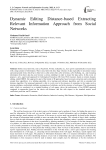
Dynamic Editing Distance-based Extracting Relevant Information Approach from Social Networks
Статья научная
Online social networks, such as Facebook, Twitter, LinkedIn, etc., have grown exponentially in recent times with a large amount of information. These social networks have huge volumes of data especially in structured, textual, and unstructured forms which have often led to cyber-crimes like cyber terrorism, cyber bullying, etc., and extracting information from these data has now become a serious challenge in order to ensure the data safety. In this work, we propose a new, supervised approach for Information Extraction (IE) from Web resources based on remote dynamic editing, called EIDED. Our approach is part of the family of IE approaches based on masks extraction and is articulated around three algorithms: (i) a labeling algorithm, (ii) a learning and inference algorithm, and (iii) an extended edit distance algorithm. Our proposed approach is able to work even in the presence of anomalies in the tuples such as missing attributes, multivalued attributes, permutation of attributes, and in the structure of web pages. The experimental study, which we conducted, on a standard database of web pages, shows the performance of our EIDED approach compared to approaches based on the classic edit distance, and this with respect to the standard metrics recall coefficient, precision, and F1-measure.
Бесплатно
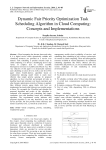
Статья научная
Cloud computing has become buzzword today. It is a digital service where dynamically scalable and virtualized resources are provided as a service over internet. Task scheduling is premier research topic in cloud computing. It is always a challenging task to map variety of complex task on various available heterogenous resources in scalable and efficient way. The very objective of this paper is to dynamically optimize task scheduling at system level as well as user level. This paper relates benefit-fairness algorithm based on weighted-fair Queuing model which is much more efficient than simple priority queuing. In proposed algorithm, we have classified and grouped all tasks as deadline based and minimum cost based constraints and after dynamic optimization, priority of fairness is applied. Here different priority queue (high, mid, low) are implemented in round-robin fashion as per weights assign to them .We recompile the CloudSim and simulate the proposed algorithm and results of this algorithm is compared with sequential task scheduling and simple constraints (cost and deadline) based task scheduling algorithm. The experimental results indicates that proposed algorithm is, not only beneficial to user and service provider, but also provides better efficiency and fairness at priority level, i.e. benefit at system level.
Бесплатно
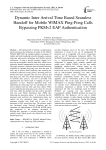
Статья научная
The rapid growth of wireless communication and its persistent use influences all walks of life. Mobile WiMAX IEEE 802.16e standard enabled convergence of mobile and fixed broadband networks through a common wide-area radio-access technology and flexible network architecture. It aims to provide seamless support to its users but an inevitable is that the long delay which occurs during the handoff management in every network process. This paper proposes a Dynamic Interval based Processing Algorithm to separate ping-pong users from the pool of users and to process them separately thus reducing the overhead of network re-entry process. Incoming users are divided into three categories like new user, old user and ping pong user. New user should undergo all the phases of network entry process, old user is provided with authentication key which leads to skipping of steps in generation of keys. Proposed algorithm deals with identifying the ping pong users by calculating the inter arrival duration and rate with same base station. When assured authenticated ping-pong users enter the network next time within the allotted time they will be provided with last used Traffic Encryption Key (TEK) thus bypassing key generation phase . It is observed that the proposed work performs the authentication phase and cancels the key generation phase which leads to minimum network entry delay and it saves to the maximum of 80% processing time. The network model was developed using Network Simulator and the algorithm was implemented in MATLAB GUIDE which gets connected to the database developed in MYSQL.This approach is justified through its timing analysis result which proves the efficient swift in the handoff processes.
Бесплатно
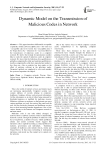
Dynamic Model on the Transmission of Malicious Codes in Network
Статья научная
This paper introduces differential susceptible e-epidemic model S_i IR (susceptible class-1 for virus (S1) - susceptible class-2 for worms (S2) -susceptible class-3 for Trojan horse (S3) – infectious (I) – recovered (R)) for the transmission of malicious codes in a computer network. We derive the formula for reproduction number (R0) to study the spread of malicious codes in computer network. We show that the Infectious free equilibrium is globally asymptotically stable and endemic equilibrium is locally asymptotically sable when reproduction number is less than one. Also an analysis has been made on the effect of antivirus software in the infectious nodes. Numerical methods are employed to solve and simulate the system of equations developed.
Бесплатно
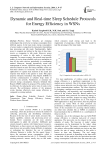
Dynamic and Real-time Sleep Schedule Protocols for Energy Efficiency in WSNs
Статья научная
Wireless Sensor Networks are emerging technologies that are diverse on energy consumption from different aspects. In the task mode, energy consumption of sensor nodes is categorized in, data packet transmitting, data processing and idle mode. Fundamentally, higher power is required and utilized at the time of data trans-receive as comparing to idle mode. However, power consumption of sensor in idle mode is necessarily important. To conserve energy, the network must provide quality of service sleep schedule, and use a mechanism to turn off the radio receiver periodically in coordinating method. Moreover, through dynamically round task management of sensors, significant energy saving can be achieved. Based on tasks and sleep schedules, nodes can form their clusters. It is necessary for real-time wireless applications to cogitate data transmit at the actual and response time based on the queries or tasks. This paper proposes Dynamic Immediate Data Report (DIDR) for real-time communication to schedule sleep mode of sensors in the network. Furthermore, to minimize the network energy consumption, Dynamic Schedule Data Report (DSDR) method is proposed. This method shows its efficiency by reducing the active time of nodes in the network. The performance analysis of the proposed works, illustrate effectively more energy efficiency as compared to existing methods.
Бесплатно
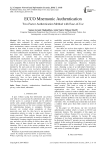
ECCO Mnemonic Authentication—Two-Factor Authentication Method with Ease-of-Use
Статья научная
Not very long ago, organizations used to identify their customers by means of one-factor authentication mechanisms. In today's world, however, these mechanisms cannot overcome the new security threats at least when it comes to high risk situations. Hence, identity providers have introduced varieties of two-factor authentication mechanisms. It may be argued that users may experience difficulties at time of authentication in systems that use two-factor authentication mechanisms for example because they may be forced to carry extra devices to be authenticated more accurately. This is however the tradeoff between ease-of-use and having a secure system that may be decided by the users and not the security providers. In this paper we present a new two-factor authentication mechanism that secures systems and at the same time is easier to use. We have used mnemonic features and the cache concept to achieve ease-of-use and security, respectively. Also, we have tested our method with almost 6500 users in real world using The Mechanical Turk Developer Sandbox.
Бесплатно
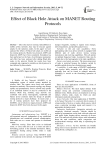
Effect of Black Hole Attack on MANET Routing Protocols
Статья научная
Due to the massive existing vulnerabilities in mobile ad-hoc networks, they may be insecure against attacks by the malicious nodes. In this paper we have analyzed the effects of Black hole attack on mobile ad hoc routing protocols. Mainly two protocols AODV and Improved AODV have been considered. Simulation has been performed on the basis of performance parameters and effect has been analyzed after adding Black-hole nodes in the network. Finally the results have been computed and compared to stumble on which protocol is least affected by these attacks.
Бесплатно
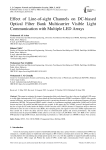
Статья научная
This paper investigates the impact of propagation delay and channel loss due to the use of multiple LED arrays in visible light communication (VLC) systems based on filter bank multicarrier (FBMC) modulation. FBMC offers greater spectral efficiency, and asynchronous transmission and is a promising alternative scheme to orthogonal frequency division modulation (OFDM). The proposed FBMC model is based on 4-quadrature amplitude modulation (QAM) and 16-QAM formats and uses 100 symbols and 600 input bits per symbol. In this paper, the VLC-FBMC system is designed based on the line-of-sight (LOS) model under the additive white Gaussian noise (AWGN) channel. Comparison analyses between different bit rates in terms of bit error rate (BER), best sampling point, and signal-to-noise ratio (SNR) requirement have been carried out to show the delay and loss effect on communication quality and system performance. The results demonstrate that the proposed FBMC model achieves a bit rate of up to 29.296 Mbit/s with a low BER of 10-3 and less SNR penalty in high QAM formats, demonstrating its potential as a viable alternative to OFDM for future VLC systems.
Бесплатно
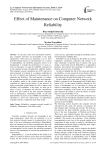
Effect of Maintenance on Computer Network Reliability
Статья научная
At the time of the new information technologies, computer networks are inescapable in any large organization, where they are organized so as to form powerful internal means of communication. In a context of dependability, the reliability parameter proves to be fundamental to evaluate the performances of such systems. In this paper, we study the reliability evaluation of a real computer network, through three reliability models. The computer network considered (set of PCs and server interconnected) is localized in a company established in the west of Algeria and dedicated to the production of ammonia and fertilizers. The result permits to compare between the three models to determine the most appropriate reliability model to the studied network, and thus, contribute to improving the quality of the network. In order to anticipate system failures as well as improve the reliability and availability of the latter, we must put in place a policy of adequate and effective maintenance based on a new model of the most common competing risks in maintenance, Alert-Delay model. At the end, dependability measures such as MTBF and reliability are calculated to assess the effectiveness of maintenance strategies and thus, validate the alert delay model.
Бесплатно

Effect of Short-Term Synaptic Plasticity on Correlated firing in Feedback Networks
Статья научная
The firing activity of a neuronal population is correlated, which has been linked to information coding and exchanging. Short-term synaptic plasticity allows synapses to increase (facilitate) or decrease (depress) over a wide range of time scales. It is critical to understand the characteristics and mechanisms of the correlated firing and the role of short-term synaptic plasticity in regulating firing activity. The short-term synaptic depression and facilitation are examined at the synapses in the inhibitory feedback loop of feedback neural networks. Numerical simulations reveal that the modulation of the correlated firing by dynamics of depression and facilitation is due to their effects on the synaptic strength. By varying synaptic time constants, the enhancement in either firing rate or intensity of oscillations can improve the correlated firing. Our study thus provides a general computational analysis of the sequential interaction of short-term plasticity with neuronal firing.
Бесплатно
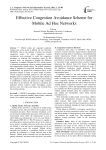
Effective Congestion Avoidance Scheme for Mobile Ad Hoc Networks
Статья научная
Mobile nodes are organized randomly without any access point in Mobile Ad hoc Networks (MANETs). Due to the mobility of nodes, the network congestion occurs. So many congestion control mechanisms were proposed to avoid the congestion avoidance or reducing the congestion status. In this research work, we proposed to develop the Effective Congestion Avoidance Scheme (ECAS), which consists of congestion monitoring, effective routing establishment and congestionless based routing. The overall congestion status is measured in congestion monitoring. In routing establishment, we propose the contention metric in the particular channel in terms of, queue length of packet, overall congestion standard, packet loss rate and packet dropping ratio to monitor the congestion status. Based on the congestion standard, the congestionless based routing is established to reduce the packet loss, high overhead, long delay in the network. By extensive simulation, the proposed scheme achieves better throughput, packet delivery ratio, low end-to-end delay and overhead than the existing schemes.
Бесплатно
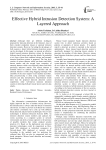
Effective Hybrid Intrusion Detection System: A Layered Approach
Статья научная
Although there are different techniques proposed for intrusion detection in the literature, most of them consider standalone misuse or anomaly intrusion detection systems. However, by taking the advantages of both systems a better hybrid intrusion detection system can be developed. In this paper, we present an effective hybrid layered intrusion detection system for detecting both previously known and zero-day attacks. In particular, a two layer system that combines misuse and anomaly intrusion detection systems is proposed. The first layer consists of misuse detector which can detect and block known attacks and the second layer comprises of anomaly detector which can efficiently detect and block previously unknown attacks. The misuse detector is modeled based on random forests classifier and the anomaly detector is built using bagging technique with ensemble of one-class support vector machine classifiers. Data pre-processing is done using automatic feature selection and data normalization. Experimental results show that the proposed intrusion detection system outperforms other well-known intrusion detection systems in detecting both previously known and zero-day attacks.
Бесплатно
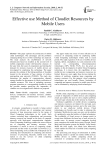
Effective use method of cloudlet resources by mobile users
Статья научная
The paper explores the architecture of mobile cloud technologies. The advantages and the problems emerging during the use of this technology are analyzed. The study analyzes the establishment of network infrastructure based on cloudlets at the second level of mobile computation clouds with hierarchic structure. At the same time, the issues of computation and meeting the demand for memory resources of mobile devices are investigated by employing this technology. The paper presents the solution of the linking problem of cloudlets located in the proximity of base stations of wireless metropolitan area networks (WMAN). The study also determines the number of communication channels among cloudlets for the purpose of effective utilization of cloudlet resources. The issue of uploading necessary program extensions to a corresponding cloudlet by using the possible number specifying the importance of cloudlets was investigated and a method was proposed.
Бесплатно
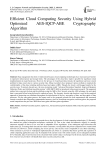
Efficient Cloud Computing Security Using Hybrid Optimized AES-IQCP-ABE Cryptography Algorithm
Статья научная
Data management has been revolutionized because cloud computing technologies have increased user barriers to expensive infrastructure and storage limits. The advantages of the cloud have made it possible for significant cloud implementation in major businesses. However, the privacy of cloud-based data remains the significant and most crucial problem for data owners due to various security risks. Many researchers have proposed various methods to maintain the confidentiality of the data, including attribute-based encryption (ABE). Though, the cloud is still dogged mainly by the security issue. To protect data privacy, the new encryption model "Advanced Encryption Standard- Improved Quantum Ciphertext Policy and Attribute-based Encryption" (AES-IQCP-ABE) is introduced in the present research. The suggested method twice encrypts the data and the attributes using the ABE at first. Second, using the AES technique, the encrypted data is encrypted before being delivered to authorized users. The dynamic, chaotic map function is used in the proposed approach to protecting user attributes throughout the initialization of the key, encryption of data, and decryption of data processes. For the encryption process, the inputs used in the proposed research are both unstructured and structured extensive medical data. Regarding computational memory, time for cloud data encryption, and decryption, the proposed model outperforms the previous ABE-based encryption and decryption algorithms.
Бесплатно
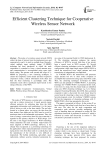
Efficient Clustering Technique for Cooperative Wireless Sensor Network
Статья научная
The nodes of a wireless sensor network (WSN) collect the data of interest from the deployment area and cooperatively send it to sink in multiple hops. Recently, virtual multiple input multiple output (V-MIMO) technique has been introduced in which the node cooperation is extended to form a virtual antenna array and communication is accomplished using space time block coding. The present work extends the scope of V-MIMO by proposing a new clustering technique. It creates the temporary cluster heads and their respective cooperative nodes, collects information from them and then the final clustering is accordingly done. The simulation result shows significant improvement in the energy efficiency of the WSN.
Бесплатно

Efficient Dynamic Resource Allocation in OFDMA Systems by Firefly Pack Algorithm
Статья научная
The resource allocation of Orthogonal Frequency Division Multiple Access (OFDMA) is one of the core issues in the next generation mobile systems. The improvement in the performance and quality of service (QoS) of communication systems is relying upon the efficient utilization of the available communication resources. The resource allocation of the OFDMA systems is mainly depends on both power and subcarrier allocations of each user for different operation scenarios and channel conditions. This paper proposes and applies Firefly Pack Algorithm (FPA) to find the optimal or near optimal power and subcarrier allocations for OFDMA systems. It takes into consideration the power and subcarrier allocations constrains, channel and noise distributions, distance between users equipments and base station, user priority weight to approximate the most of the variables, constrains, and parameters that encounter in the OFDMA systems. Four important cases for the number of subcarriers and users are addressed, simulated, and analyzed with employing the FPA algorithm under specific operation scenarios to meet the standard specifications. The results demonstrate that FPA is an effective algorithm in finding the optimal or near optimal for both subcarrier and power allocation.
Бесплатно

Efficient FPGA Hardware Implementation of Secure Hash Function SHA-2
Статья научная
The Hash function has been studied by designers with the goal to improve its performances in terms of area, frequency and throughput. The Hash function is used in many embedded systems to provide security. It is become the default choice for security services in numerous applications. In this paper, we proposed a new design for the SHA-256 and SHA-512 functions. Moreover, the proposed design has been implemented on Xilinx Virtex-5 FPGA. Its area, frequency and throughput have been compared and it is shown that the proposed design achieves good performance in term of area, frequency and throughput.
Бесплатно
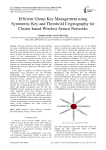
Статья научная
Research in Wireless Sensor Networks (WSNs) has made a significant progress recently, especially the area of key management, which plays a central role for protecting group communication in sensor networks. In sensor networks, the data are crucial and have to keep secrecy in data communication. To achieve data confidentiality, adversary should not have access to the group communication. Therefore due to the limited memory resources and energy constraints of sensor nodes, reducing the communication and storage overhead, and improving the resilience against the node capture attack become a must. In this paper we propose An Efficient Group Key Management using Symmetric Key and Threshold Cryptography for Cluster based Wireless Sensor Networks (EGKMST). The proposed scheme considers a hierarchical cluster structure of sensor network and adopts the pair-wise key management and group key management based on threshold key cryptography to generate and to distribute the keys efficiently within a cluster and updates periodically keys. By this way EGKMST provides continuous transmission security and avoids dangerous attacks from malicious nodes and mitigate the node compromise attack in WSNs communication. The security and performance analysis illustrate that EGKMST scheme achieves the requirement of group communication and provides efficient security with low communication cost, low memory overhead and energy saving compared with some existing key management schemes.
Бесплатно
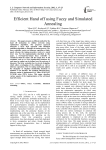
Efficient Hand off using Fuzzy and Simulated Annealing
Статья научная
This paper presents an efficient method for the hand off mechanism in cellular networks using optimization algorithms. The proposed approach integrates a fuzzy logic approach with simulated annealing algorithm to automate the tuning process. The fuzzy controller carries out inference operation at high-speed, whereas the tuning procedure works at a much lower rate. For the implementation described in this paper, a two-input-one-output fuzzy controller is considered. Both the inputs and the output have 8- bit resolution, and up to seven membership functions for each input or output can be defined over the universe of discourse. The fuzzy controller has two levels of pipeline which allows overlapping of the arithmetic as well as inference operations. The SA tuning mechanism adjusts the triangular or singleton membership functions to minimize a cost function. The complete self-tuned fuzzy inference engine is implemented in a Xilinx SPARTAN3 XC3S200 series FPGA device. This paper describes various aspects of the implementation of the self-tuned hand off system.
Бесплатно
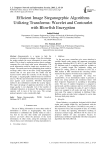
Статья научная
Steganography is a means to hide the existence of information exchange. Using this technique the sender embeds the secret information in some other media. This is done by replacing useless data in ordinary computer files with some other secret information. The secret information could be simple text, encoded text or images. The media used as the embedding plane could be an image, audio, video or text files. Using steganography ensures that no one apart from the sender and the receiver knows about the existence of the message. In this paper, a steganography method based on transforms used i.e. Wavelet and Contourlet. Devised algorithm was used against each transform. Blowfish Encryption method is also embedded to double the security impact. The major advantage of applying transforms is that the image quality is not degraded even if the number of embedded characters is increased. The proposed system operates well in most of the test cases. The average payload capacity is also considerably high.
Бесплатно

